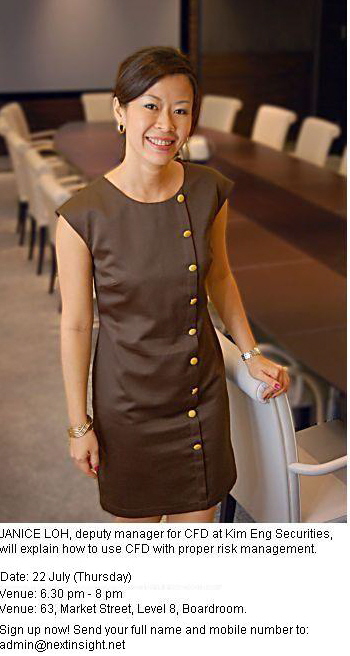
DOLPHY YEO, 28, is a senior financial planner with a global financial institution. She uses Contracts for Differences (CFDs) largely for shorting stocks, which is the key way to profit in a market or stock downturn.
The short-selling feature is only half the story. You can also use CFDs to go ‘long’ – ie, buy a stock and sell it later at a higher price.
|
CFD allows you to leverage up to 10 times your deposit – eg. to buy $30,000 worth of Capitaland, your CFD account needs to be funded for $3,000.
If Capitaland moves in your favour, the unrealized profit is immediately credited to your account, and vice versa.
The use of leverage cuts both ways: it will magnify your gains – and losses.
In the current bearish market, the flexibility of CFDs for ‘short-selling’ is what traders like Dolphy appreciate.
A CFD short position can be held indefinitely, unlike a 'naked' short in the cash market which must be covered back within the same day or risk hefty fines imposed by the Exchange.
It is no wonder that CFDs have quickly gained popularity since it was introduced some years ago.

We asked Dolphy to explain more about her experience with CFDs:
Q When did you start using CFDs?
Dolphy: I started investing in stocks in 2008 using my cash account, and then a friend introduced me to CFDs in the second half of 2009 when the market was volatile.
I have used CFDs to short stocks – for very brief periods. Sometimes I would even take profit or cut loss within the day. CFD is great for short term trading; I use it to take advantage of knee jerk reactions in the market.
Q: How do CFDs fit into your investment approach?
Dolphy: I have long term investments like unit trusts (which I do monthly top-ups, or what is called dollar-averaging), and I have insurance cover, but no share holdings at the moment.
If there is action in the stock market, I take positions using CFD to do quick trades. It is more like an instrument for pocket money. CFDs also charge interest for open positions, so I don’t use it for long term investments.
Q: How would you describe your comfort level with using CFDs?
Dolphy: I am already comfortable with trading in the cash market, so trading CFD was a natural progression. I only had to learn to navigate the platform.
One thing about CFD is that because my trades are based on market sentiment or news, I need to spend time to track the market once I open a position. Because CFD positions are leveraged, losses can escalate if I don’t pay attention and I may go into margin call.

Q: What are the risks of CFDs that you are mindful of?
Dolphy: The biggest risk of trading CFDs is market risk – that means the risk that my trades are in the wrong direction. This is the same as with trading the cash market I guess.
Some CFD providers charge rollover fees every 30 days. This is where an open position is closed and opened again immediately, and so commission can come up to a hefty sum. I trade with Kim Eng, and fortunately they do not impose this and so I do not have rollover risk.
Read about an earlier CFD seminar : How to make the best use of CFD ('the best thing since contra')
|







